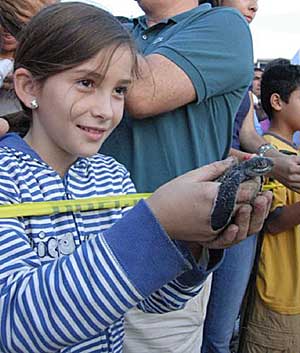Puerto Vallarta, Mexico - Every June, sea turtles start arriving on the shores of Riviera Nayarit to nest their eggs. Forty-five days later, their eggs begin to hatch attracting visitors from all over looking to experience the magic of life first-hand by taking part in the Banderas Bay region's turtle hatching season.
With up to 1,000 eggs per night being released during the peak months of September and October, every visitor is sure to have a hand in the region's unique sea turtle-releasing activity. Ecologically friendly, Riviera Nayarit recognizes the importance of all of its living inhabitants and takes great strides to ensure their survival and the preservation of natural habitats.
The official mascots of Riviera Nayarit, four protected species of sea turtles, are native to the area. The leatherback turtles, Olive Ridley turtles, hawksbill turtles, and green turtles all use the 192 mile coastline of Nayarit as a nesting site every year. Each generation of female sea turtles returns to the beach where they were born to create nests of their own, resulting in a wonderful tradition in which visitors can participate.
 |
You can help newborn turtles through the first steps of their lives at the Grupo Ecologico de la Costa Verde marine turtle nursery, the Platanitos Turtle Camp, Delcanto or the Ecological Group of Nayarit on Playa el Naranjo.
During the summer and fall months, travelers can volunteer or go on tours of these nurseries and nesting sites to learn about the fascinating life cycle of sea turtles for just one night or by participating in a two-month volunteer project, subject to availability.
Delcanto is an eco-friendly development with a Turtle Conservation program dedicated to preserving the habitat of the sea turtles. The Delcanto's beach becomes an alternative for the activities of the Nuevo Vallarta Sea Turtle Protection and Conservation Center. For more information on Delcanto's program, visit DelCanto.com.mx.
At the Grupo Ecologico de la Costa Verde marine turtle nursery, visitors and volunteers can help release turtle hatchlings into their natural habitat. Just after sundown, the baby turtles are let out into the ocean to become independent. Also, every Wednesday night, the organization presents a slideshow at the Costa Azul Hotel for travelers and participants to learn about sea turtles.
Interested visitors who want to volunteer in depth with the organization must stay for a minimum of two months and will have the chance to join in almost every step of helping the turtles survive their delicate first days. Volunteers pay for their own expenses.
Short-term visitors can take tours of the nursery and release the hatchlings or help with whatever is needed that night at the nursery. For information on the organization, visit project-tortuga.org. For more information on packages at the Costa Azul Hotel, visit CostaAzul.com.
Located at Playa Las Tortugas, the Platanitos Turtle Camp is focused on protecting and increasing the Olive Ridley sea turtle population. A joint effort between the Mexican government environmental agencies CONAP and SEMARNAT and the Home Owners Association of Playa Las Tortugas and its developer Robert Hancock, the camp promises to give travelers an unforgettable, exciting turtle experience.
Visitors can help the staff patrol the beach and collect eggs from nesting turtles, and then learn how to incubate eggs in order to achieve a higher survival rate. When hatching time comes, participants in the program can watch as the newborn turtles begin their journey through the ocean to their new life.
Options for participation include one-time visits or long-term volunteering. Cost is based on suggested donations depending on the number of participants and the extent of the visit. For more information, visit the organization's new website, SeaTurtleCamp.org.

